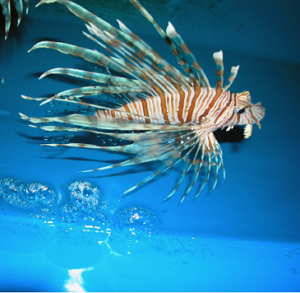What’s in a Name?
Aquatic invasive species are organisms that live within inland, estuarine, or marine waters, have been spread to locations where they do not naturally occur, and cause economic or environmental harm or harm to human health. In addition, they negatively impact the quality of outdoor recreation experiences.
Other terms may be used to describe organisms living outside their native range, including nonindigenous, alien, exotic, non-native, nuisance, or hitchhiker. Keep reading to find out how these terms relate to each other.
Nonindigenous species, as defined by the Nonindigenous Aquatic Nuisance Prevention and Control Act of 1990, is any species or other viable biological material that enters an ecosystem beyond its historic range. This term is often used interchangeably with “alien,” which was defined by Executive Order 13112 as any species, including its seeds, eggs, spores, or other biological material capable of propagating that species, that is not native to the particular ecosystem in which it is found. These terms are also synonymous with “non-native” and “exotic”.
In other words, nonindigenous = alien = exotic = non-native.
The Nonindigenous Aquatic Nuisance Prevention and Control Act further defines an aquatic “nuisance” species as a nonindigenous species that threatens the diversity or abundance of native species or the ecological stability of infested waters, or commercial, agricultural, aquacultural or recreational activities dependent on such waters. Similarly, Executive Order 13751 (amending the older EO 13112) defines ‘invasive species’ with regard to a particular ecosystem, as a non-native organism whose introduction causes or is likely to cause economic or environmental harm, or harm to human, animal, or plant health. Aquatic “invasive” species are invasive species that occur in freshwater, estuarine, or marine waters.
Thus, aquatic nuisance species and aquatic invasive species are synonymous and can be used interchangeably.
In brief, the terms nonindigenous, alien, exotic, and non-native only refer to species moved outside their native range. However, not all species that move outside their native range cause harm to our economy, our environment, or human health. The few that do are, by definition, nuisance or invasive.
Aquatic invasive species that can be transported through recreational activities are Aquatic Hitchhikers.
Aquatic invasive species pose an ongoing threat to the environment, economy, recreation, and human health and safely. These species are a direct driver of biodiversity loss, yet also hinder economic development, serve as vectors of disease, decrease the aesthetic value of nature, and prevent recreational activities. Keep reading to learn more about these specific threats.
Aquatic invasive species can upset the balance of an ecosystem in a number of ways. Perhaps the most significant impact is the widespread loss of habitat.
Aquatic invasive species can kill large numbers of native species. They may prey upon them, compete with them for food and space, interbreed with them, or introduce harmful pathogens and parasites.
Aquatic invasive species can transform ecosystems so that they no longer function normally.
Many of our recreational activities depend on healthy native ecosystems. Aquatic invasive species may negatively impact the quality of our outdoor recreation experiences, reduce access to these areas, and threaten human health and safety.
Aquatic invasive species are seen as a threat not only to native biodiversity and ecosystem functioning, but also to economic development. The damages to human enterprises caused by these species result in enormous economic costs. Aquatic invasive species can reduce production of fisheries, decrease water availability to residential and commercial users, block transport routes, choke irrigation canals, foul industrial and public water supply pipelines, degrade water quality, accelerate filling of lakes and reservoirs, and decrease property values.
As an example, aquatic invasive species dramatically increase the operating costs of public utilities, power plants, municipal drinking water facilities and manufacturing facilities. These industries all need a constant supply of water. However, many invasive plants and animals form dense colonies that clog water intakes, forcing industries to use costly control methods to maintain their systems. The costs incurred from these control methods are often passed onto consumers.
Here are some figures to illustrate specific impacts from aquatic invasive species:
When aquatic invasive species are introduced into new waters, much is at stake. Jobs and dollars are only the beginning. Aquatic invasive species have the potential to create significant, long-term ecological harm that may impact everyday life for current and future generations.

One of the most direct effects to human health from aquatic invasive species is the spread of disease. Throughout history, diseases have spread using other species as vectors. This includes malaria, yellow fever, bubonic plague, and, more recently, West Nile virus. However, the effect on public health extends beyond disease and parasites; human injury may also result.
We are living in a very different era where goods, people and services are being shipped around the world. Because of this globalized economy, different species are hitchhiking through many different pathways. Species can be moved to new locations in many different ways and most are a result of human activity, including recreational activities. Some common way that species may be moved during recreational boating and other activities include:
Just one organism, or in some case a piece of a plant, is enough to start a new invasion.
Fortunately – ALL invasions are preventable!
By following the Clean Drain Dry procedure, recreational users can easily eliminate their role in the spread of aquatic invasive species. Find out more.
These hitchhiker species are represented by plants, animals and microorganisms. So, it is important to make sure all of our recreational activities are clean; meaning that we don’t bring any hitchhikers with us. Below are a few of the more higher profile aquatic invasive species to help you understand the different forms that these invaders can take and what you need to look for when you clean – drain – and dry your equipment.